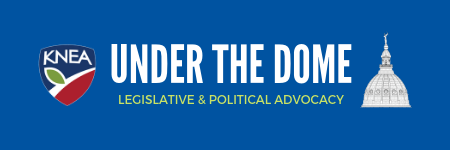After ending last week in dramatic fashion, it seems the Legislature is a bit tired – at least the light schedule we’re following might indicate so. Many of the committees we routinely follow are holding meetings “on the call of the chair” and the chairs are so far not calling many meetings.
The House Education Committee met yesterday to hear reports on Communities in Schools and Jobs for America’s Graduates, two programs intended to support at-risk students and working to give them a positive, successful school experience. The Committee will hold hearings on two bills tomorrow. HB 2542 modifies fees that may be charged to Kansas private and out-of-state postsecondary
educational institutions. HB 2540 allows school districts to develop policies under which students not enrolled in the district or enrolled part time might participate in activities.
The House K-12 Education Budget Committee, in their only scheduled meeting so far this week, held a meeting today to hear a report on concurrent enrollment programs. Blake Flanders of the Kansas Board of Regents and Education Commissioner Randy Watson presented the report. This was a joint meeting with the Senate Education Committee. The remainder of the week is “on call of the chair.”
The Senate Education Committee will meet tomorrow to hear a presentation by the Kansas Commission for the Deaf and Hard of Hearing and then on Thursday for an overview on Advanced Placement and International Baccalaureate programs.
Both the House and Senate Tax Committees will meet on Thursday. In the morning, the Senate Committee will hold a hearing on Senate Concurrent Resolution 1604, a constitutional amendment lowering the food sales tax to 4% in FY 2019 and 2% in FY 2020 and beyond. The House Tax Committee will meet in the afternoon to hear about efforts by other states to collect internet sales taxes.
And related to last week’s drama, Rep. Melissa Rooker (R-Fairway) has introduced HB 2561 which would codify the state department practice of adjusting transportation funding to a “curve of best fit.” While this adjustment has not been part of the statutory formula, it has been practice for many years under direction from legislators in the 1970’s when the formula was crafted.


